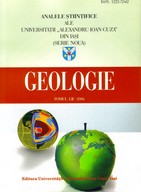The aim of the present study is to illustrate the accumulation of heavy metals through
spontaneous flora grown on wastewater sludge storage areas in order to apply
phytoremediation as a rehabilitation method.

English title
- SERIA
GEOLOGIE (AUI-G) - |

|
| Log in New account |
| Home | Main Page | Guide for Authors | Peer Review | New Articles | Events | Archive | Index | Contact us |

|
Article RESEARCH REGARDING THE PHYTO-REHABILITATION OF THE SLUDGE STORAGE AREA FROM WASTEWATER TREATMENT PLANTS
IRINA ELENA MARINCIUC - Prut - Bârlad Basin Water Administration, Th. Văscăuțeanu street, 10, 700462, Iași, Romania VIRGINIA CATRINA - „Al. I. Cuza” University of Iași, Department of Geology, 20A Carol I Blv., 700505, Iași, Romania RADU LĂCĂTUŞU - National Institute of Research and Development in Soil Science, Agrochemistry and Environment – ICPA, 61 Mărăşti Blv., Bucharest, Romania RODICA LAZĂR - National Institute of Research and Development in Soil Science, Agrochemistry and Environment – ICPA, 61 Mărăşti Blv., Bucharest, Romania DANIELA TOPALĂ - S.C. APAVITAL S.A. Iaşi, 6 Mihail Costăchescu street, 700495, Iași, Romania View abstract as pdf file | View full article as pdf file Abstract: The increasing amount of sewage sludge produced in developed countries, especially in
metropolitan cities, has been one of the primary environmental issues the European Union
has had to deal with. The wastewater and sludge from municipal wastewater treatment
plants contain valuable nutrients, yet represent a pollution source because of the heavy
metal content. In order to naturally restore the wastewater sludge storage areas, it is
necessary to apply rehabilitation technologies. It is important to develop feasible and
economical technologies for removing heavy metals from wastewater sludge.
Phytoremediation is an alternative technology for the enhanced remediation of
environments contaminated with heavy metals. Phytoremediation is a process that uses
plants to remove, transfer, stabilize, and destroy contaminants in soils and sediments. The
mechanisms include enhanced rhizosphere biodegradation, phyto-extraction (also called
“phyto-accumulation”), phyto-degradation, and phyto-stabilization.
Keywords: phytoremediation, sewage sludge, heavy metal |
copyright © 2024 Department of Geology |